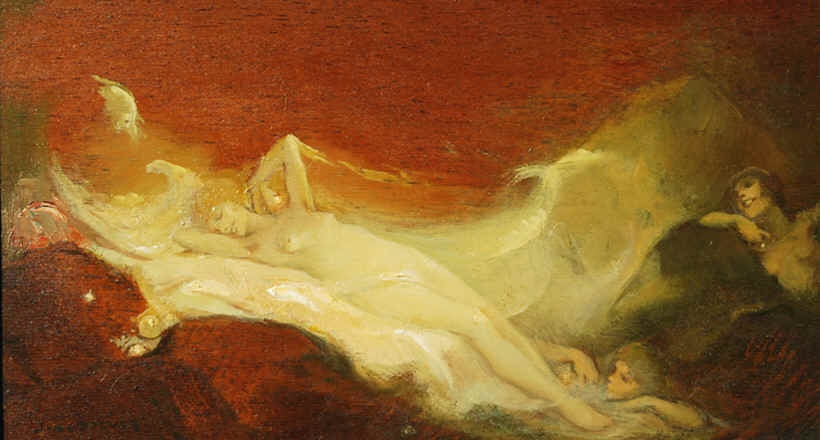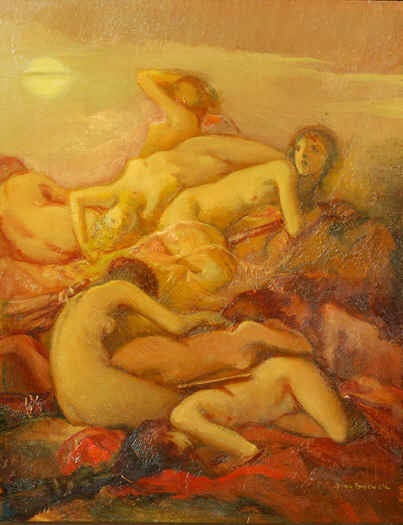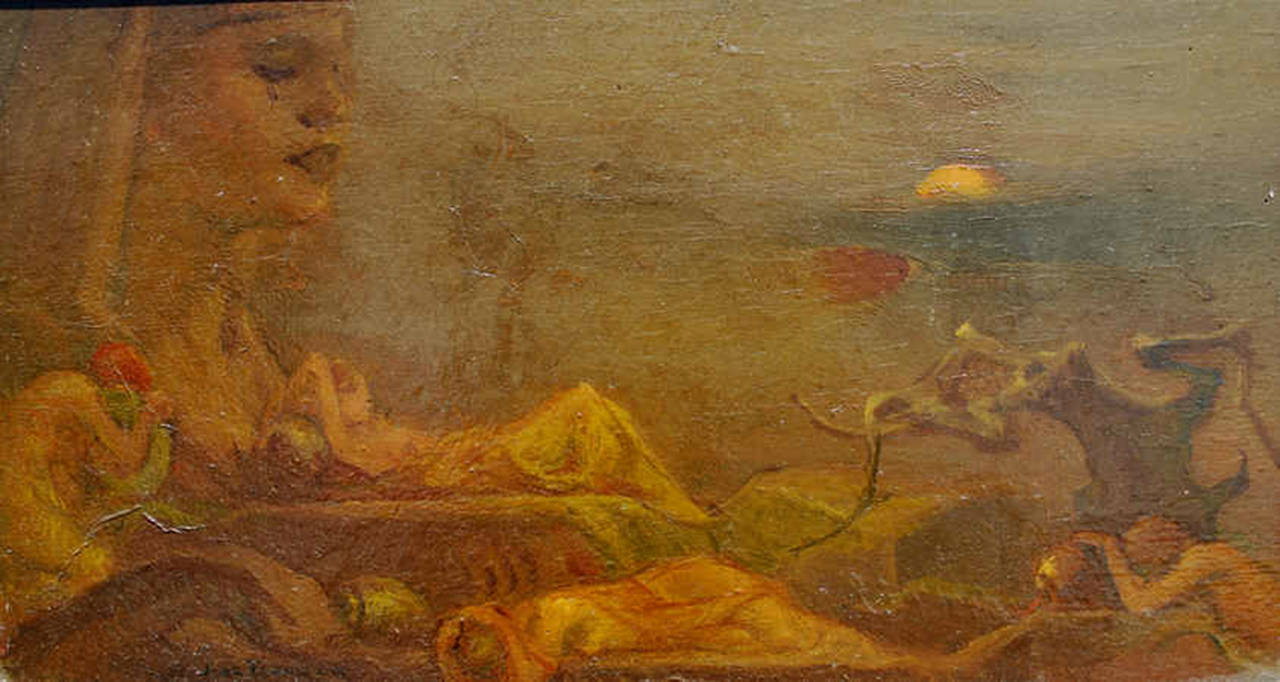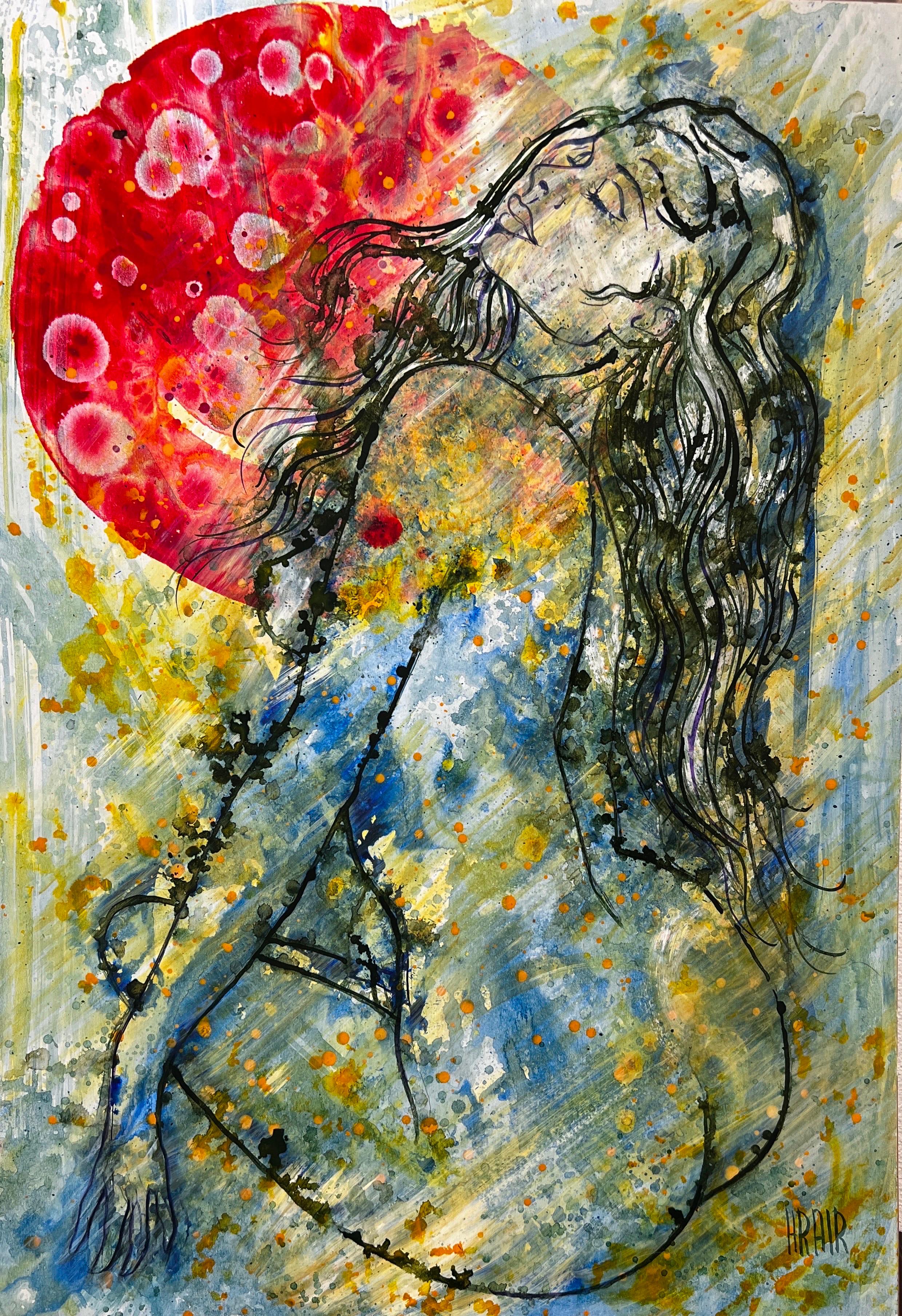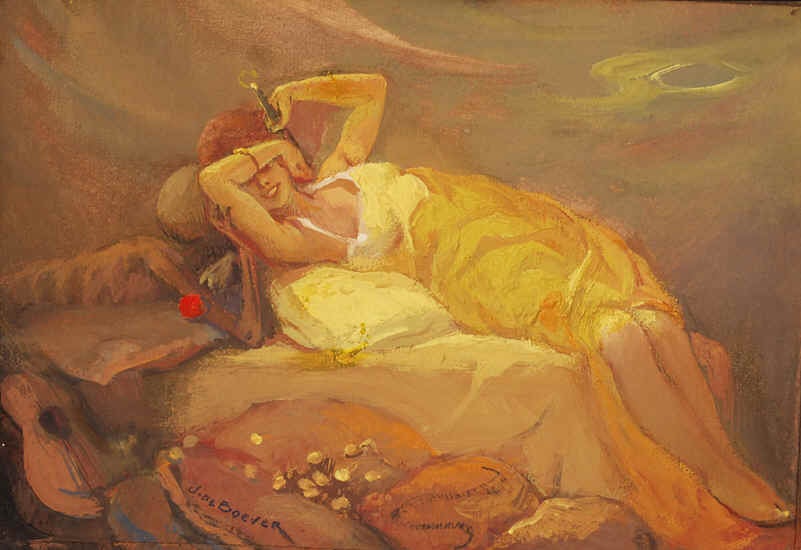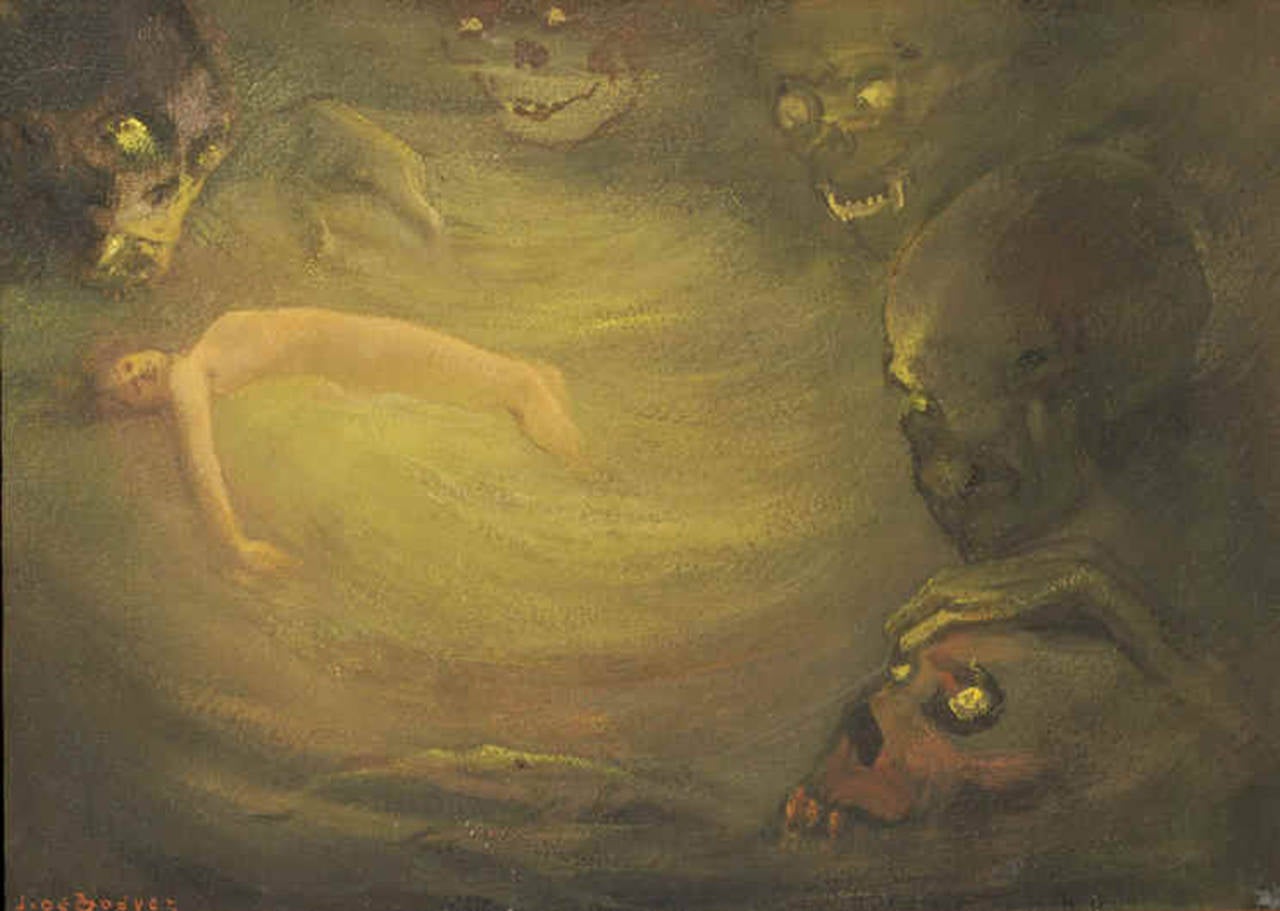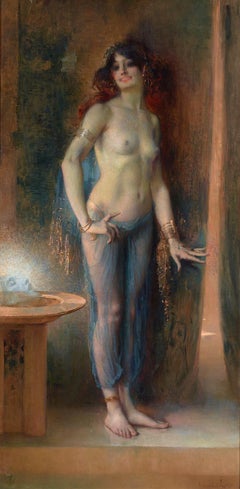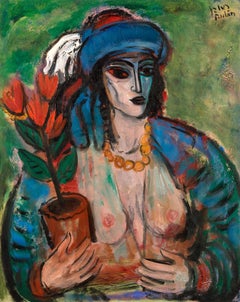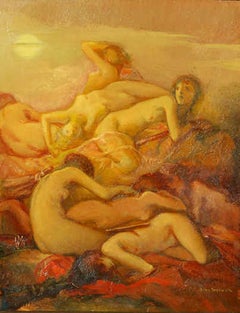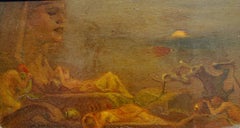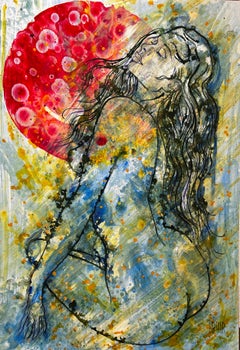Want more images or videos?
Request additional images or videos from the seller
1 of 8
Pierre Marcel-BéronneauOndine1816-1918
1816-1918
$49,850
£36,990.63
€43,089.02
CA$69,391.56
A$77,273.76
CHF 40,216.72
MX$952,776.17
NOK 512,190.73
SEK 481,409.63
DKK 321,497.55
Shipping
Retrieving quote...The 1stDibs Promise:
Authenticity Guarantee,
Money-Back Guarantee,
24-Hour Cancellation
About the Item
Mystical and mysterious, a mythological Ondine rests beside an ethereal forest pond in this majestic, original oil on canvas by French Symbolist Pierre-Amédée Marcel-Béronneau. A student of the famed Gustave Moreau, Béronneau painted some of the most ornate scenes ever envisioned which focused upon entrancing figures of classical mythology.
Ondine, or Undine, is a female elemental being of ancient origin that is used to describe nymphs, mermaids, naiades and the like. In lore, the beings reside near pools, ponds and waterfalls and are known for their captivating singing voices that are said to have a hypnotic effect on men. These immortal figures, though they may resemble women lack one of the most important human characteristics – a soul. Here, in true Symbolist fashion, Béronneau creates a breathtakingly vivid dream world in which this Ondine is prominent. Her lack of color, as compared to her surroundings, seems to reflect the absence of this most essential of mortal traits. Though graceful and unquestionably beautiful, without a soul the Ondine is unable to truly experience an enriched and fulfilled life.
Born to a locksmith and a housewife in Bordeaux, Béronneau received his initial training at the Municipal School of Fine Arts in his hometown and later Paris’ Decorative Arts School. In 1892, he enrolled into the Academie des Beaux-Arts where he entered the studio of Gustave Moreau. Béronneau quickly became one of the master’s best pupils. In a letter of recommendation to the Mayor of Bordeaux, Moreau wrote: “Mr. Béronneau, my student, is a wonderful worker, very gifted and worthy of your interest.”
Béronneau would go on to have a tremendously successful career, winning numerous awards and honors throughout his lifetime. He exhibited at the Salon and the Salon des Indépendants from 1895, garnering medals in 1900, 1913 and 1926. The art critic Arsène Alexandre wrote about him in the paper “Le Figaro” that he was a “great refined artist”, a “delicate, serious and often deep painter who [mixed] a great integrity with the yearning for the highest thoughts”. The French government also commissioned works, such as his “Last Hour”, currently found in the collection of the Fine-Arts Museum in Bordeaux. He became Knight of the Legion of Honor in 1914.
Provenance:
The artist’s estate;Private collection, France;Sotheby’s Olympia, 2003;Private collection; United Kingdom
Canvas: 28 7/8” high x 23 5/8” wide Frame: 35 1/4” high x 30 1/8” wide
- Creator:Pierre Marcel-Béronneau (1869 - 1937, French)
- Creation Year:1816-1918
- Dimensions:Height: 35.25 in (89.54 cm)Width: 30.13 in (76.54 cm)
- Medium:
- Movement & Style:
- Period:
- Condition:
- Gallery Location:New Orleans, LA
- Reference Number:Seller: 30-92561stDibs: LU1864931921
About the Seller
5.0
Vetted Professional Seller
Every seller passes strict standards for authenticity and reliability
Established in 1912
1stDibs seller since 2013
17 sales on 1stDibs
Typical response time: 9 hours
- ShippingRetrieving quote...Shipping from: New Orleans, LA
- Return Policy
Authenticity Guarantee
In the unlikely event there’s an issue with an item’s authenticity, contact us within 1 year for a full refund. DetailsMoney-Back Guarantee
If your item is not as described, is damaged in transit, or does not arrive, contact us within 7 days for a full refund. Details24-Hour Cancellation
You have a 24-hour grace period in which to reconsider your purchase, with no questions asked.Vetted Professional Sellers
Our world-class sellers must adhere to strict standards for service and quality, maintaining the integrity of our listings.Price-Match Guarantee
If you find that a seller listed the same item for a lower price elsewhere, we’ll match it.Trusted Global Delivery
Our best-in-class carrier network provides specialized shipping options worldwide, including custom delivery.More From This Seller
View AllSalome
Located in New Orleans, LA
This compelling portrait of Salome was composed by the French painter Marie Felix Hippolyte-Lucas. While the celebrated artist's oeuvre is filled with bright and cheerful portraits of aristocratic women surrounded by florals, here he takes a different approach. Hippolyte-Lucas' Salome is simultaneously exotic and highly modern, rendered in a style that is both theatrical and bold. The monumental work's rich color palette is filled with gem-inspired hues that lend drama to the scene, highlighting the blatant sexuality of this legendary seductress.
Though Salome is not named in the New Testament, she has appeared time and time again in art and literature over the centuries, as both an innocent and a seductress. Her mother, Herodias, resented John the Baptist, who denounced her marriage to King Herod as unlawful. At one evening meal, Salome danced...
Category
19th Century Other Art Style Nude Paintings
Materials
Canvas, Oil
Price Upon Request
Leda and the Swan by Ludovic Alleaume
By Ludovic Alleaume
Located in New Orleans, LA
Ludovic Alleaume
1859-1941 French
Leda and the Swan
Oil on canvas
Signed (lower left)
This spectacular circular composition by Ludovic Alleaume presents one of mythology's most e...
Category
20th Century Figurative Paintings
Materials
Oil, Canvas
Orientala By Reuven Rubin
By Reuven Rubin
Located in New Orleans, LA
Reuven Rubin
Israeli 1893-1974
Orientala
Signed “Reuven Rubin"
Oil on canvas
A striking and unique work rendered in a breathtaking jewel-toned palette, Orientala by Rueven Rubin ...
Category
20th Century Post-Impressionist Nude Paintings
Materials
Canvas, Oil
Ciel incertain by Jean-Pierre Cassigneul
By Jean-Pierre Cassigneul
Located in New Orleans, LA
Jean-Pierre Cassigneul
b.1935 French
Ciel incertain
(Uncertain Sky)
Signed “Cassigneul” (lower left)
Oil on canvas
This exquisite painting by Jean-Pierre Cassigneul, titled Ciel ...
Category
20th Century Post-Impressionist Figurative Paintings
Materials
Canvas, Oil
Mutine
By Guillaume Seignac
Located in New Orleans, LA
Guillaume Seignac
1870-1924 French
Mutine
Signed “G. Seignac” (lower right)
Oil on canvas
A mischievous maiden dominates this garden scene by French Academic artist Guillaume S...
Category
Late 19th Century Academic Nude Paintings
Materials
Canvas, Oil
Après le bain (After the bath)
By Pierre Auguste Renoir
Located in New Orleans, LA
For Pierre-Auguste Renoir, Impressionism's pre-eminent figure painter, depicting the nude was an exercise in bringing the canvas to life. He once said, “I look at a nude, I see myriads of minuscule shades. I have to find those which will make the flesh on my canvas come to life and resonate.” This compelling portrait by Renoir entitled Après le bain presents the nude figure of a woman in a serene, private moment, absorbed in the task of drying herself after a bath. The artist’s mastery of light and shading is incredible, achieving a sense of vitality in this otherwise ordinary scene.
Renoir is celebrated for his figural work, especially his Rubenesque female nudes, however, it was not until the artist was in his forties that he depicted the nude with any frequency. In 1881, Renoir traveled to Italy, where he studied the works of the Renaissance masters and the ancient art of Pompeii and Rome. Upon his return to France, the nude became his favored subject, and he used the motif to combine the spontaneity of Impressionism with the solid modeling of classical painting. Renoir’s medium here, sanguine, a reddish-brown chalk, was used extensively in the Renaissance by Leonardo (who employed it in his sketches for the Last Supper), Michelangelo and Raphael. Its warm hue lends itself well to depicting flesh, and the chalk drawing allows for a greater focus on line, form and texture in a departure from the aspects of color and light that so often preoccupied the Impressionists. Après le bain conveys the impression of arrested motion with perfect naturalness, deftly capturing the moment before the elegant lines of the sitter's form change position.
The sitter is almost certainly Gabrielle Renard, the nanny to Renoir’s children and a frequent model for the artist. Gabrielle was the cousin of Renoir’s wife, Aline, and came to Montmartre to work for the family at the age of 16. She developed a strong bond with the family and became a favorite subject for Renoir, appearing in several of his most important works, including his 1911 Gabrielle with a Rose (Musée d'Orsay). When Renoir began to suffer from severe rheumatoid arthritis that would eventually leave him unable to walk and scarcely able to grasp a paintbrush, it was Gabrielle that would assist the artist by positioning the paintbrush between his crippled fingers.
Born in Limoges, France in 1841, Renoir began his career as an apprentice to a painter of porcelain wares. He later moved to Paris at the age of 21, enrolling at the prestigious École des Beaux-Arts. It was here, while studying under Charles Gleyre, that Renoir attained a tremendous appreciation for the academic style of painting, a quality that would last throughout his career. This was also when he met Claude Monet and several other classmates, with whom he would later form the Impressionists.
Working closely with Monet, Renoir began experimenting with the portrayal of light and its effect on his canvases. The youngest member of the Impressionist movement, an astute Renoir recognized how a subject was constantly changing due to the dynamic effects of light on color. Relying heavily upon his academic training that focused on composition, lines and descriptive details, Renoir distinguished himself among his contemporaries. His intuitive use of color and expansive brushstroke, along with acute attention to his subject, have placed him among the finest painters in history.
This work is accompanied by a certificate of authenticity and will be included in the forthcoming catalogue raisonné of the work of Pierre-Auguste Renoir from the Wildenstein Plattner Institute.
Circa 1898
Canvas: 43 1/2" high x 35 1/2" wide
Frame: 57 3/4" high x 49 1/4" wide
Provenance:
Galerie Durand-Ruel, Paris (acquired from the artist on January 25, 1899)
J. Pereire Collection, France (1966)
Sam Salz, New York (before 1981)
Claus Virch, Paris
French Compagny, Inc., New York
Larry Silverstein, New York (circa January 1987)
Le Clos de Sierne Gallery, Geneva
Galerie Heyram, Paris (October 1987)
Francis Gross
M.S. Rau, New Orleans
Literature:
B. Schneider, Renoir, Berlin, 1957, p. 95 (illustrated in color, p. 83)
M. Gauthier, Renoir, Paris, 1958, p. 83 (illustrated in color; erroneously dated '1916' and titled 'Woman in her toilet')
F. Fosca, Renoir, L'homme et son obra, Paris, 1961, p. 280 (illustrated, p. 95; erroneously dated 'about 1890' and titled 'After the Bath...
Category
19th Century Impressionist Nude Paintings
Materials
Canvas, Paper, Chalk
Price Upon Request
You May Also Like
Nereides
By Jan Frans Deboever
Located in West Hollywood, CA
Belgian Symbolist artist Jan Frans DeBoever (1872 - 1948), created symbolist/allegorical paintings throughout his lifetime. He centralized on allegorical and literary subjects, gener...
Category
1920s Symbolist Paintings
Materials
Oil, Panel
Price Upon Request
Sorcieres
By Jan Frans Deboever
Located in West Hollywood, CA
Soricieres, depicts a covenant of witches as they convene at the top of a fabled mountain in Germany, the Broeken. The legend states that on a single night of the year, St. Walpurgis...
Category
1910s Symbolist Figurative Paintings
Materials
Oil, Panel
Price Upon Request
"Sirenes"
By Jan Frans Deboever
Located in West Hollywood, CA
Belgian Symbolist artist Jan Frans DeBoever (1872 - 1948), created symbolist/allegorical paintings throughout his lifetime. He centralized on allegorical and literary subjects, gener...
Category
1930s Symbolist Figurative Paintings
Materials
Oil
Price Upon Request
Nude, Volupte.
By Hrair Diarbekirian
Located in La Canada Flintridge, CA
We are thrilled to present to you one of Hrair's mesmerizing oil paintings titled "Volupte" This exquisite artwork, is signed lower right. is a true testament to the artist's skill a...
Category
2010s Symbolist Nude Paintings
Materials
Oil
Confidence
By Jan Frans Deboever
Located in West Hollywood, CA
Belgian Symbolist artist Jan Frans DeBoever (1872 – 1949), created symbolist/allegorical paintings throughout his lifetime. He centralized on allegorical and literary subjects, gener...
Category
Symbolist Figurative Paintings
Materials
Mixed Media
Price Upon Request
"L'irremediable - Les Fleurs des Mal"
By Jan Frans Deboever
Located in West Hollywood, CA
Belgian Symbolist artist Jan Frans DeBoever (1872 - 1948), created symbolist/allegorical paintings throughout his lifetime. He centralized on allegorical and literary subjects, gener...
Category
1920s Symbolist Figurative Paintings
Materials
Oil
Price Upon Request
More Ways To Browse
Vintage Nymph
8 Immortals
Forest Nymph
Sunset Peter Max
Tea Room Depression Glass
Ted Fuller
Thomas Rowlandson Engraving
Tinsel Print
Tintin Sculpture
Tom Wesselmann Great American Nude Series
Tommy Jackson
Twelve Months Of Flowers
Valerie Thornton
Victor Safe
Vintage Bermuda Poster
Vintage Boeing Poster
Vintage Bucking Bronco
Vintage Circus Props
